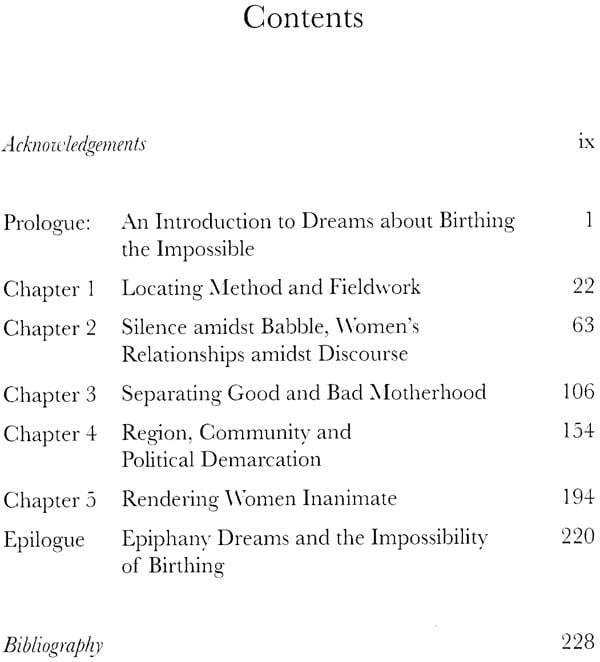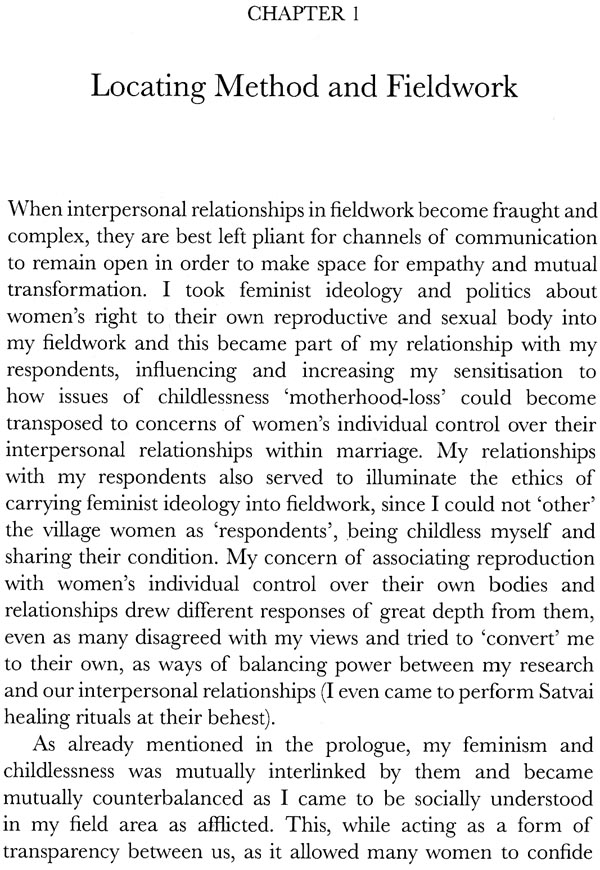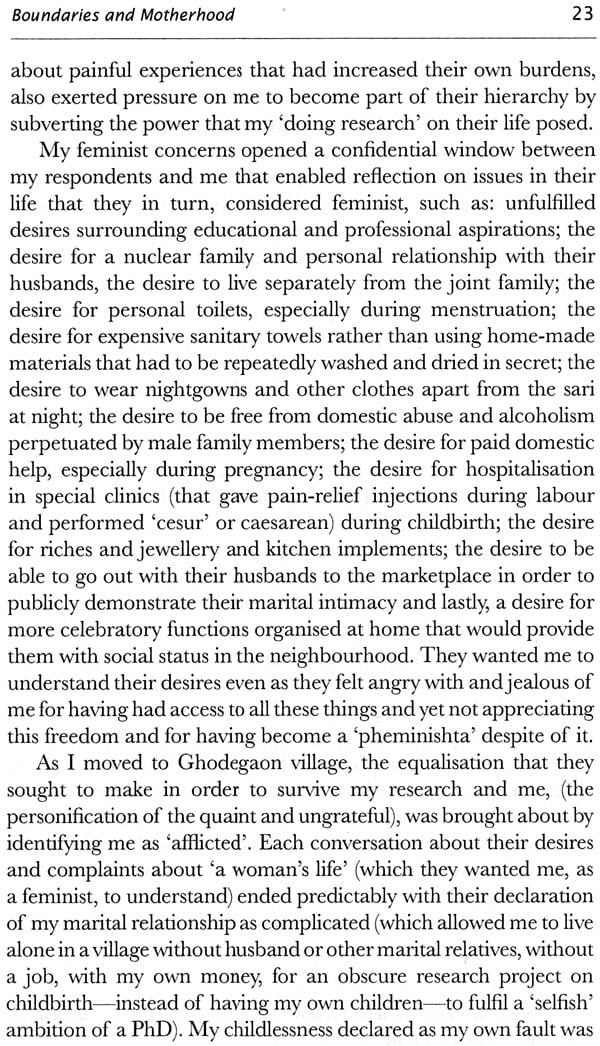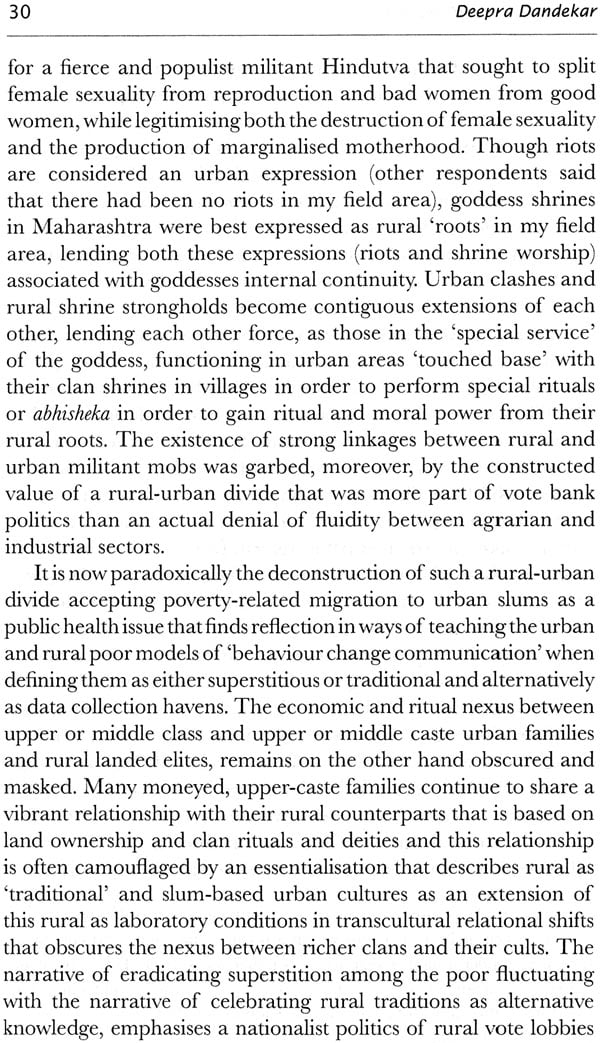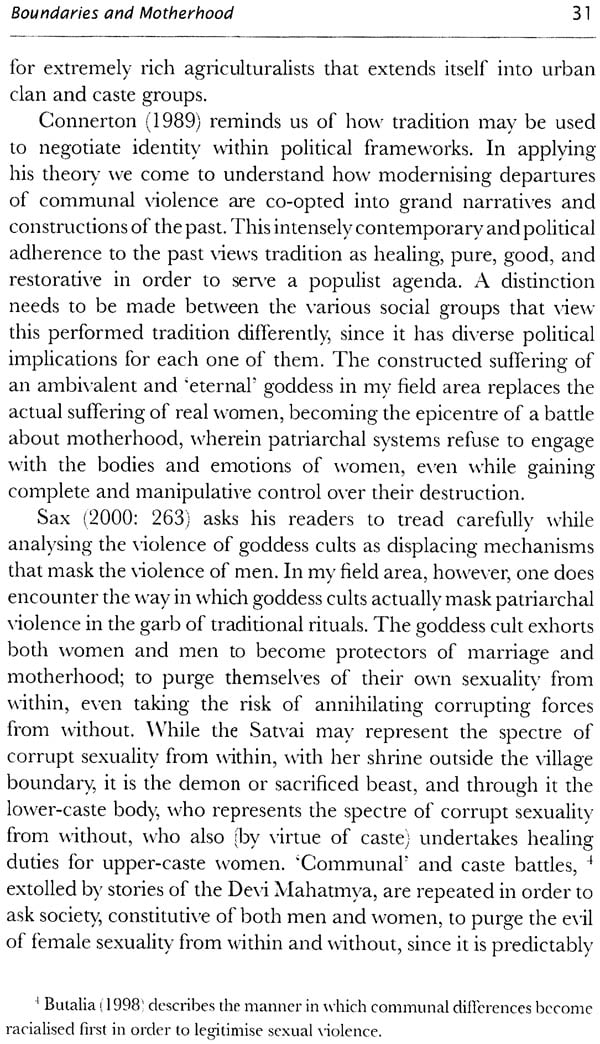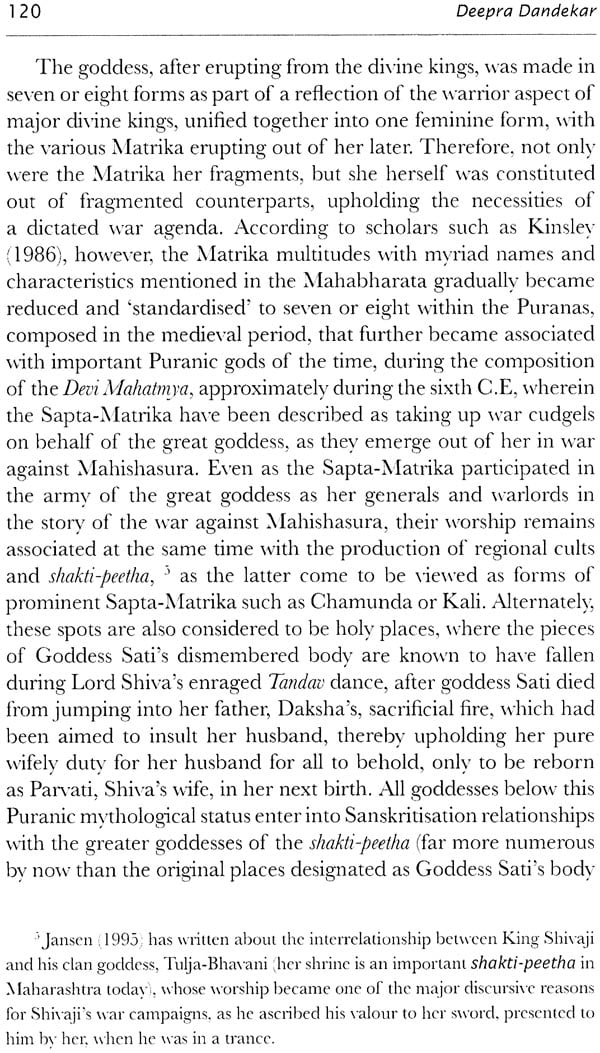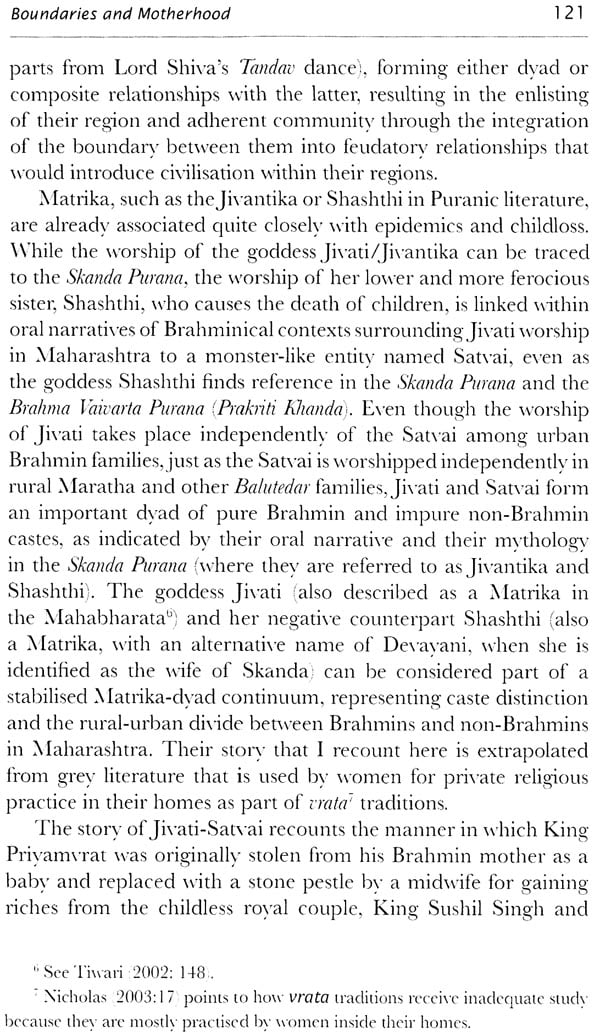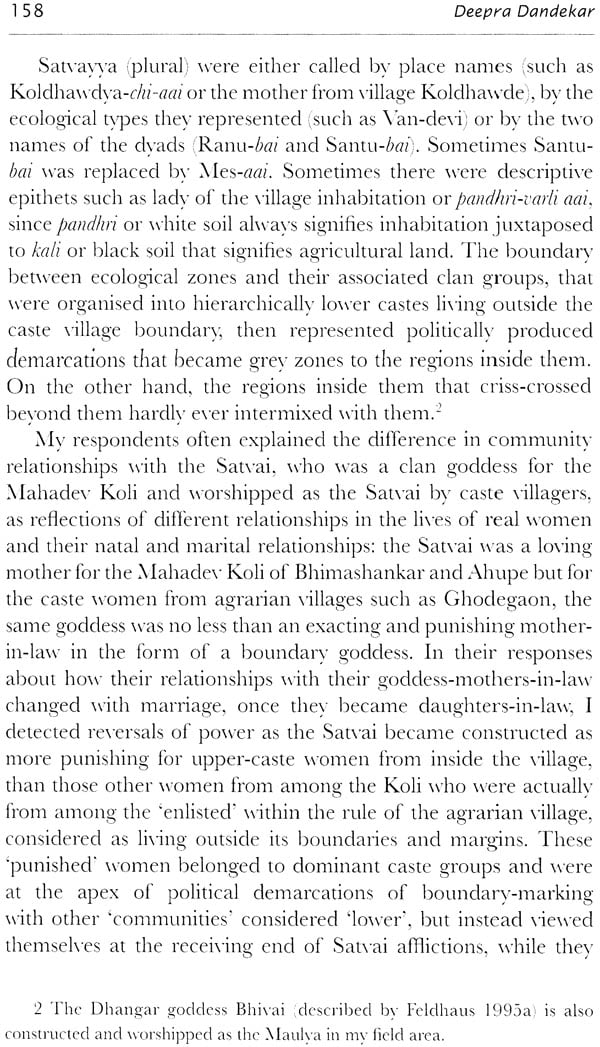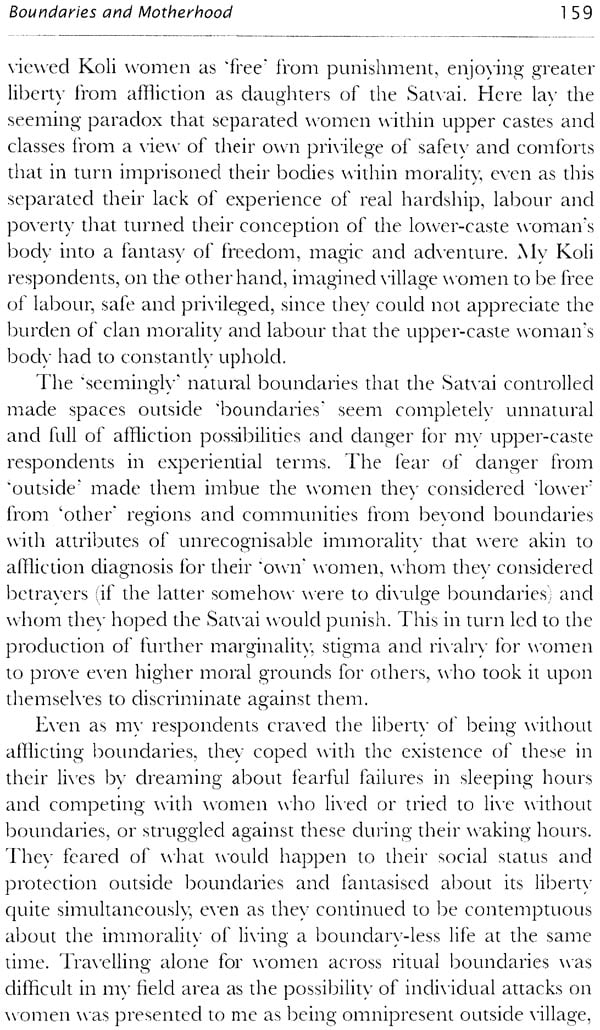
Boundaries and Motherhood (Ritual and Reproduction in Rural Maharashtra)
Book Specification
| Item Code: | NAS193 |
| Author: | Deepra Dandekar |
| Publisher: | Zubaan Publications |
| Language: | English |
| Edition: | 2016 |
| ISBN: | 9789383074501 |
| Pages: | 246 |
| Cover: | HARDCOVER |
| Other Details | 8.50 X 5.50 inch |
| Weight | 390 gm |
Book Description
This book links caste and gender to the social production of motherhood. The author argues that in contradiction to the assumption that motherhood is a primarily female- centred and positive domain, subaltern agency produces it as malign, dangerous, malevolent and marginal. Highlighting the manner in which the experience and expression of motherhood is constructed as androgynous and non-threatening to patriarchal hegemony, the author emphasizes the consolidation of ‘lower’ caste positive identity through valorization processes and shows how high caste and class ownership and power produce the birth and survival of a male child as their ideological validation.
Little has been written about the experiences of motherhood in India. Much research has focused on maternal mortality/ morbidity and child morbidity/mortality as elements that inform public health statistical concerns. Here, the author reinvents and deconstructs existing notions of maternity by interrogating the very systemic and patriarchal nature of its language that depoliticizes oppression.
Deepra Dandekar is a post-doctoral researcher at the Cluster of Excellence ‘Asia and Europe in a Global Context’ at the University of Heidelberg, Germany.
I would like to define my primary engagement at the beginning of this book as one that describes motherhood as systemically constructed through childbirth/child-loss goddess cults, represented by the Satvai and Maulya in rural Maharashtra, as marginal and associated with village inhabitation boundaries. I begin this prologue with the most poignant aspect of my fieldwork: women’s dreams, even as I end this book with dreams in the epilogue, which are mine. These dreams represent, to my mind, the suffering associated with the goddess cult in the lives of childless and motherhood-less women and contribute to a discourse of ‘child loss’ that is as powerful as the discourse of childbirth, both constructed academically to create a predominant view of women as fertile and birth-giving. The recounting of dreams that I have elected to begin this book with, depicts childless women and motherhood-loss/child-loss to be that eternal shadow-land of womanhood that each childbirth and motherhood is equally imbued with. Childless women or witches and mothers are like the reflections of goddess dyads themselves, representing the fluid relationships between pure and impure forms.
My women respondents often spoke of dreams that linked goddesses with important indications or premonitions about their children and the purity of their reproductive lives, which were at the same time threatened with affliction (ritual diagnosis pertaining to their experiences of child loss, subsequent childlessness or the inability to have either children or more specifically sons). ‘These dreams were like a hotline between goddesses and married women, who were still considered of reproductive ability. However, in order to understand these dreams, a little needs to be explained first about these goddesses and the systemic manner in which they preside over motherhood-loss in my field area and the prevalent discourse about how performing their rituals averts and heals from affliction, even if these afflictions are sent by the same goddess to women who are deemed impure.
Goddesses ‘harm’ and ‘heal’ women at the same time, curing them from the very afflictions that they send as part of a punishment and a reminder of their moral duty of motherhood and purity. Women who are afflicted by the goddess for having become impure, therefore, perform healing rituals and for this purpose come into contact with margins and boundaries of village inhabitations where goddess shrines are located. ‘They are themselves considered peripheral to their marital clans, until their moral recalcitrance is not considered purged and they are not cured of what is considered impure, resulting in the subsequent birth of sons. Village goddesses presiding over childbirth primarily protect village clans (women’s marital clans), securing them with male inheritance first by ‘converting’ and recruiting the women married into them as pure mothers and wives. The womanhood, wifehood and motherhood duties and domestic labour that goddess rituals create within these converted and ‘colonised"’ women thereafter, concentrate on producing a subjectivity of non- owning’ valour among them in relation to husbands and sons, since they are themselves created as ‘owned’ through rituals. Feelings of overwhelming attachment with one’s own biological sons are considered to go against the welfare of the clan unit, since it might instil a sense of competition between agnatic women and their children, which is considered to benefit the enemies of the clan, since these rituals create sons as clan and land ‘owners’ and their mothers as owned by marital clans and lands as its progenitors.
My respondents always pointed to the Ramayana while explaining the quality of this ‘competitive’ motherhood. Overwhelming emotions of personal attachment to one’s own son (a form of affliction and cannibalism) could only be traditionally known to those outsider hostile women, who knew the inside of one’s body, like the midwife. In mythical times, Queen Kaikeyi’s secret sin of overwhelming attachment to her son, that even went against her marital clan’s interests, was known to her maid and midwife, Manthara, who could exploit this knowledge to her own benefit against her enemies, Kaikeyi’s husband Dasharatha and the whole Suryavanshi clan, whose downfall was wrecked because a weak queen, too attached to her son, confided about it to an outsider, a midwife, who was a secret enemy of the king’s clan and the state (thus making the whole unhappiness of King and Lord Rama a mistake about motherhood). My respondents felt that interactions between a mother and a midwife needed to remain distanced and mediated by the mother’s marital clan to avoid any breach of interest against the clan and to avoid secrets being exchanged during intimate services that were provided in ‘body-solitude’. This also minimised the chances of accusations being levied against both mothers and midwives in the future if something went wrong during childbirth.
**Contents and Sample Pages**
